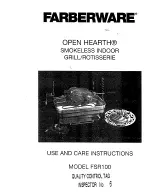
3
control valve and will immediately go into lockout mode
for CSD1, or proceed to two more trials before locking
out in the standard version.
14 The ignition module will go into lockout if it does not
see the flame rectification signal due to the flame
sensor being insulated from oxide deposits or from the
sensor rod grounding out due to improper placement or
from a damaged ceramic insulator.
15 The tip of a properly located sensor rod will be ¾” to 1”
away from the burner surface. The µA reading can be
conveniently taken at the front of the ignition module at
the ‘Flame Sense Test’ terminals.
1.5.1 IGNITION
PROCESS
1
The Ignition module supplies voltage to the Air/Gas
Ratio Control Valve through proof of closure switch and
a latching relay.
2
Air/Gas Ratio Control Valve senses the pressure
differential between the Combustion Air Fan outlet and
the vent outlet and supplies gas to the orifice and into
the Fan inlet to pre-mix with air.
3
The Gas/Air mixture is forced into the Burner and out
of the Burner Ports under pressure at soft start input
rate.
4
Hot Surface Igniter lights the Gas/Air mixture and the
Flame Sensor serves as a means to prove Main
Burner Flame by rectification.
5
Burner is now firing at soft start input rate.
6
Variable Frequency Drive adjusts fan speed based on
desired water temperature set point or input signal
from remote operator 4-20 mA or 2-10VDC signal
(must be specified at time of placing order).
7
Burner input rate is variable down to approximately
30% of rate or up to 100% of rate as required to satisfy
the set point.
1.5.2
HEAT TRANSFER PROCESS
1
Burner Input continues to increase until water
temperature reaches the Set Point temperature.
2
Burner Input may stabilize at a fixed rate where
demand equals input.
3
Burner Input will decrease rate when water
temperature approaches temperature Set Point.
1.5.3
END OF SEQUENCE
1
Set Point temperature is satisfied.
2
Power to the gas valves is turned off.
3
Combustion Air Fan ramps to a stop over the factory
preprogrammed time period of 60 seconds.
4
Thermostat is now in a standby mode waiting for the
next “Call for Heat”.
WARNING
To minimize the possibility of serious personal injury, fire or
damage to your appliance, never violate the following
safety rules.
WARNING
IMPROPER INSTALLATION, ADJUSTMENT,
ALTERATION, SERVICE OR MAINTENANCE
can cause
injury or property damage. Refer to this manual. For
additional information, consult a qualified installer, service
agency or gas supplier.
DO NOT
Do not use this appliance if any part of it has been
under
water
. The possible damage to a flooded appliance can be
extensive and present numerous safety hazards. Any
appliance that has been
under water
must be replaced
WHAT TO DO IF YOU SMELL GAS
Do not try to light any appliance. • Do not touch any electric
switch: do not use any phone in your building. •
Immediately call your gas supplier from a neighbor’s phone.
Follow the gas supplier’s instructions. • If you cannot reach
your gas supplier, call the fire department.
IMPORTANT
Consult and follow local Building and Fire Regulations and
other Safety Codes that apply to this installation. Contact
the local gas utility company to authorize and inspect all
gas and flue connections.
Installation and service must be performed by a
qualified installer, service agency or the gas supplier.
WARNING
Should overheating occur or the gas supply fails to shut off,
DO NOT
turn off or disconnect the electrical supply to the
pump. Shut off the gas supply at a location external to the
appliance.
WARNING
Operation of Non-Condensing DynaFlame at low fire (less
than 100% of input) for long periods of time will increase
the possibility of forming condensation in the flue,
particularly in Spring/Fall operation.
•
Boilers and water heaters are heat producing
appliances. To avoid damage or injury, do not store
materials against the appliance or the vent-air intake
system. Use proper care to avoid unnecessary contact
(especially children) with the appliance and vent-air
intake components.
•
Never cover your appliance, lean anything against it,
store trash or debris near it, stand on it or in any way
block the flow of fresh air to your appliance.
•
UNDER NO CIRCUMSTANCES
may flammable
materials such as gasoline or paint thinner be used or
stored in the vicinity of this appliance, vent-air intake
system or any location from which fumes could reach
the appliance or vent-air intake system.
•
A gas appliance that draws combustion air from the
equipment room where it is installed must have a
supply of fresh air circulating around it during burner
operation for proper gas combustion and proper
venting.
1.6 CODES
The equipment shall be installed in accordance with
those installation regulations in force in the local area
where the installation is to be made.
These shall be
carefully followed in all cases. Authorities having jurisdiction
shall be consulted before installations are made. In the
absence of such requirements, the installation shall
conform to the latest edition of the National Fuel Gas Code,
ANSI Z223.1 and/or CAN/CGAB149 Installation Code. All
electrical wiring must be done in accordance with the
Содержание DFH500
Страница 31: ...28 PART 9 TROUBLE SHOOTING ...
Страница 32: ...29 ...
Страница 39: ...36 PART 12 EXPLODED VIEW ...
Страница 40: ...37 ...
Страница 41: ...38 ...
Страница 46: ...43 PART 13 ELECTRICAL DIAGRAMS ...
Страница 47: ...44 ...
Страница 48: ...45 ...
Страница 49: ...46 ...
Страница 50: ...47 ...
Страница 51: ...48 ...







































